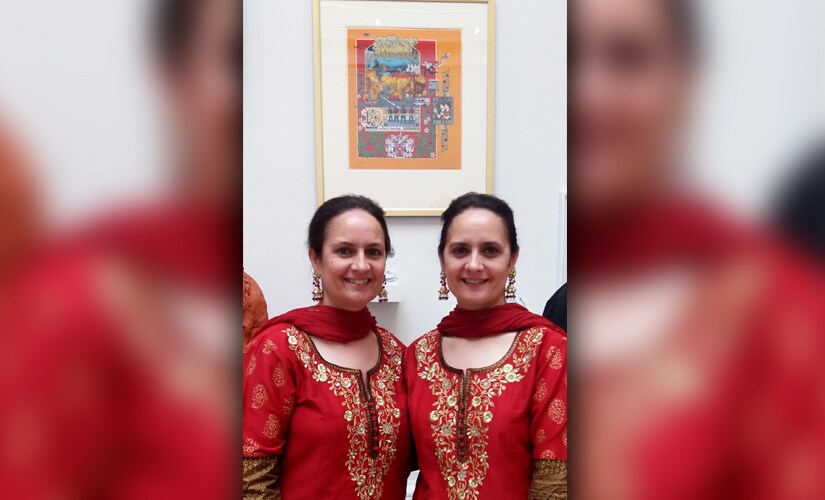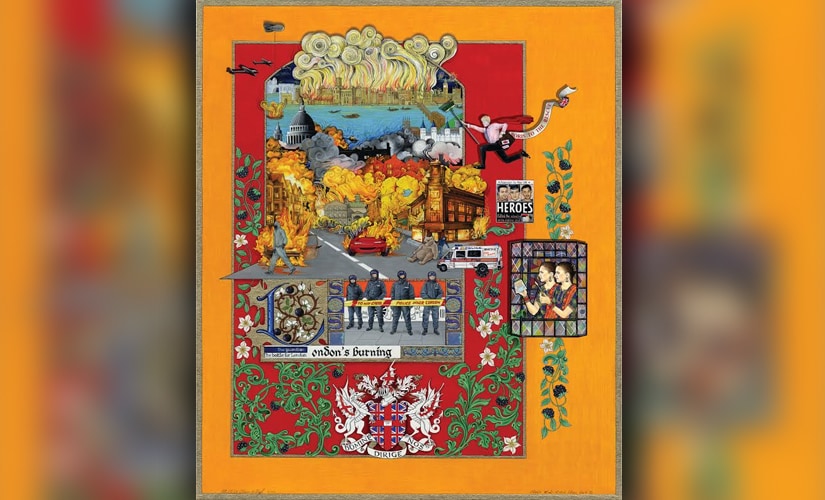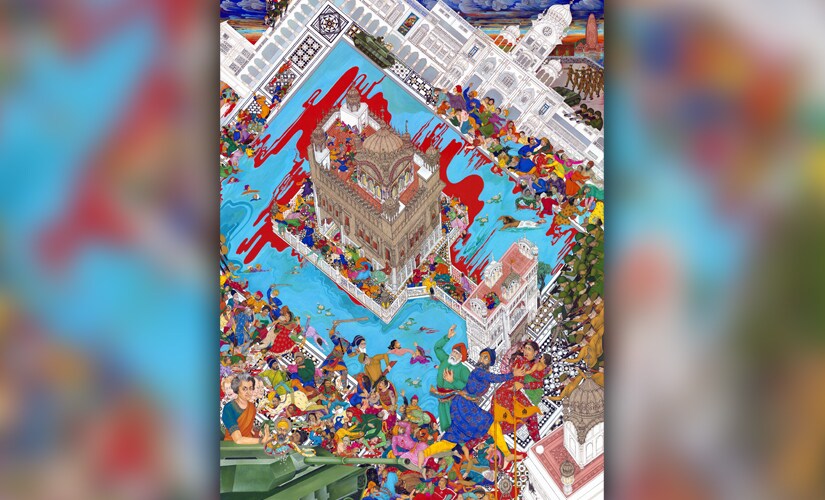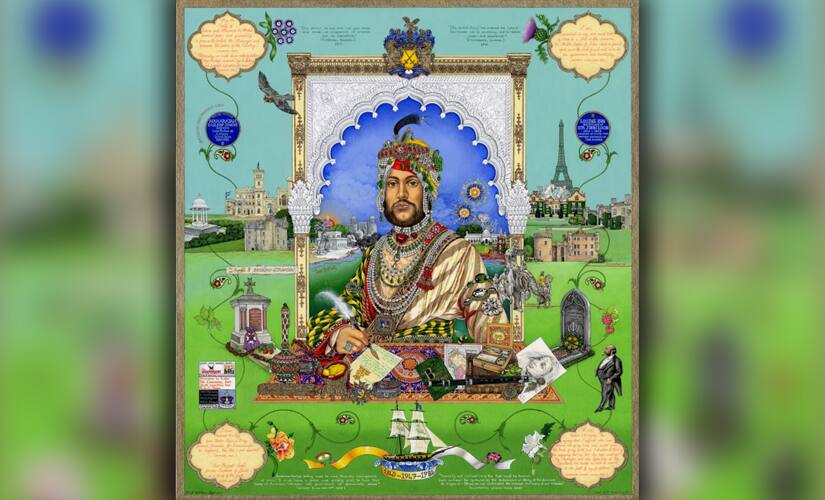The history of European art is often considered synonymous with the development of the idea of European individualism. In schools across European countries, individualism is a byword not limited to situating the idea of art within the geography of psychology, but situating it within the landscape of life itself. What would then two sisters who look like each other, paint like each other, and have similar inclinations and ideas, do differently? The Singh Twins, as they like to call themselves, have been answering that question for about two decades, and with some currency left in the wallet to engender praise, and not for the most visible trait that makes the two unique — their mutual oneness. Amrit and Rabindra Kaur’s family moved to London during the turmoil of Partition. Born in London, the two sisters at the age of four moved along with their family to Liverpool where they have continued to live till today. “We grew up in a quiet little village and were sent to a Catholic Convent school for its high standards of education, discipline and spiritual grounding. We were the only Indians and non-Christians there, but it didn’t stop us getting involved in the religious life of the school,” the twins say. (They insist that all quotes be attributed to both of them.) “So from the age of seven when we started at the school, this Christian imagery — rich in iconography, symbolism, decoration and narrative — played a huge part in influencing our aesthetic taste and led to our love of Art Nouveau, Renaissance, Pre-Raphaelite and Symbolists art. As children we spent our spare time drawing fantasy and fairytale images inspired by these art movements,” they add. [caption id=“attachment_2881256” align=“alignnone” width=“825”]  The Singh Twins — Amrit and Rabinder Kaur[/caption] But being similar and not just in the physical sense, comes with the kind of baggage most people, let alone artists, are not familiar with carrying. Further, the sisters work on the same painting simultaneously, which is as curious an approach as it is must be difficult to execute. “At school we were first separated in class and then placed in different classrooms, against our will. Later, when we were studying 20th century Western Art History as part of a BA (Hons) degree in Combined Studies, we were heavily criticised by our art tutors for developing similar styles of work (something that was a natural outcome of our joint love for the Indian miniature tradition rather than any conscious decision on our part to be the same). They felt we were not being individual enough. Which went against the ideal they held and taught about ‘individuality’ being ‘the be all and end all’ of contemporary art,” the twins say. [caption id=“attachment_2881262” align=“alignnone” width=“825”]  London’s Burning, Read All About It. Copyright @ www.singhtwins.co.uk[/caption] Despite an embedded sense of ‘pop’ in their works, and its rising value in the West, the twins, contrary to logic some might say, took to reviving the Indian miniature tradition. “We absolutely fell in love with miniature paintings when we discovered them during our first trip to India as teenagers in 1980. The technical skill, intricate detail and imaginative compositions; their beautiful jewel-like quality with the illuminated gold work, their narrative power; their satire (often used within the social and political themes) and their rich symbolic language, fascinated us,” the twins say. Indian miniature paintings over the years have found themselves being replaced with a penchant for the European aesthetic, embodied in the several artistic movements to have run with the likes of Picasso as their central inspiration. And this is something the twins have witnessed for themselves. “We were very disappointed to see how modern Indian art seemed by and large to be following western trends and aesthetics rather than looking to Indian art for inspiration. Not only that, but it seemed that India in general no longer valued this art form which was reduced to cheap imitations for the tourist industry,” the twins say. [caption id=“attachment_2881268” align=“alignnone” width=“825”]  Nineteen Eighty-Four. Copyright @ www.singhtwins.co.uk[/caption] As part of an Indian family, albeit one living in the progressive West, women are expected to abide by a certain culture and way of living that enhances our proclivity for social participation. How then did the two unabashedly learn, experiment and express while refusing to accommodate tenets like that of marriage? “We were the first girls in our family to go to University and to be encouraged to develop a career for example. And in fact, being women has actually been beneficial to us because we were not expected to have to go out and earn a living as such. Unlike many artists early on in their career, we didn’t have to sell our work to survive or get a second job to support ourselves,” the twins say. That said, Amrit and Rabindra have had to hone their art of over a period of time, and not without the criticism of their peers and mentors regarding subjects that are rooted most certainly in tradition rather than the modern. For all that the two sisters have been criticised, they have refused to conform to popular opinion. Even their subjects have not been without their share of controversy. A painting titled Nineteen Eighty-Four, which shows the Golden Temple after Operation Blue Star, garnered them praise but a fair share of negative reviews, as it was termed ‘violent’ by some. “The feedback to 1984 moved us but it also humbled us because we don’t feel that we had been particularly brave in depicting this event. It is easy to speak out against injustice when you are not in fear of serious repercussions. We sometimes wonder if we lived in Punjab whether we might perhaps have thought twice about creating it?” the twins say. [caption id=“attachment_2881260” align=“alignnone” width=“825”]  Casualty of War: A Portrait of Maharaja Duleep Singh, Collections National Museums Scotland. Copyright @ www.singhtwins.co.uk[/caption] But the work that gave the two sisters a sizeable reputation was the portrait of the last Sikh king, Maharaja Duleep Singh. In 2009, the National Museum of Scotland commissioned the sisters to draw a portrait with attention focused on the belongings of the Maharaja that were part of the museum’s collection. “We had been fascinated by the tragic story of Maharaja Duleep Singh for many years. It was a dream commission!” say the twins. “As the starting point of the painting, the museum objects became a key visual focus of the piece. We responded to them in terms of what they represented to us as Sikhs — namely, the nostalgia of a bygone era and the ‘glorious’ days of the Sikh Empire with all its wealth and power on the one hand, but also the spoils of war and conquest representing a stolen heritage — both collective and personal (in the case of Duleep Singh and his family) — on the other," they add. The portrait was regarded positively by most, while some went on to term it as the “Reclamation of the Last Maharaja”. The sisters, had indeed, reclaimed a bit of Indian colonial history from a popular narrative, in the backyard of the power that perpetuated it in the first place. Both Amrit and Rabindra stress their affiliation to and longing for their homeland. “Despite living here (in the UK), our lives and our work is a reflection of our cultural values that continue to be inspired by our very Indian traditions,” they say. When asked about the revered portrait of the Raja and whether they would like to re-claim anything in India the sisters say, “It would be the re-appreciation for traditional spiritual and family values that we feel, sadly, appear to be losing importance against the influence and drive for Western life styles and materialism.” For now, theirs is a lonely presence that accounts for modern sensibilities marked by Indian tradition, in art, in the west. And there has been evidence in the past, to suggest that they will continue to paint in the same image, two at a time, quite literally. Works by the Singh twins are currently being showcased as part of the Royal Academy Summer Exhibition in London up till 21 August
The Singh twins — Amrit and Rabindra Kaur — talk to Firstpost as their art goes on display at the Royal Academy Summer Exhibition in London
Advertisement
End of Article


)
)
)
)
)
)
)
)
)



